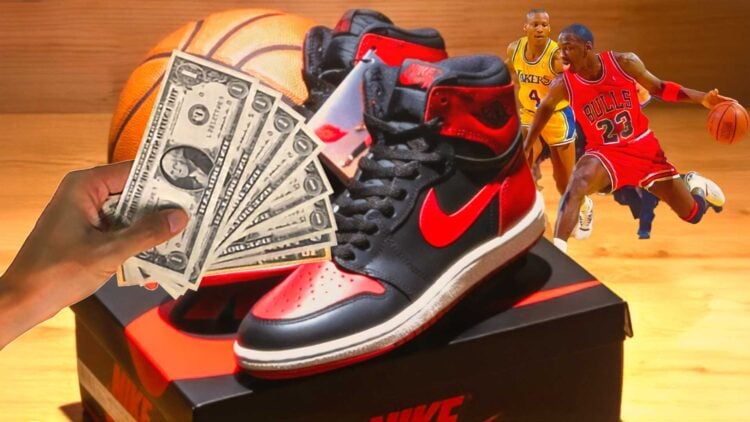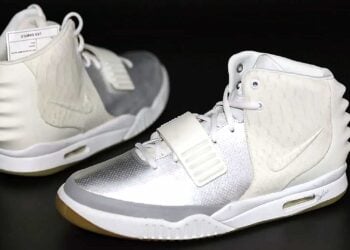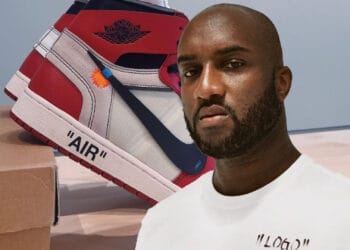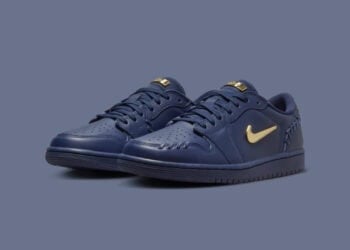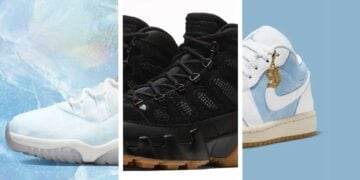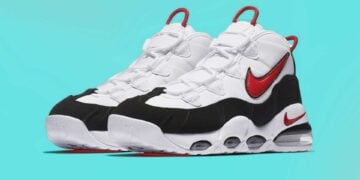Over the years, sneakerheads have noticed a very clear pattern. We all know that Nike’s marketing strategy masterfully combines celebrity endorsements, technological innovation, and targeted storytelling to create a compelling narrative around the brand. But just how deep does all this really go, and what has the Swoosh brand actually done to get you to buy the latest sneakers?
A Very Strong Swoosh Brand
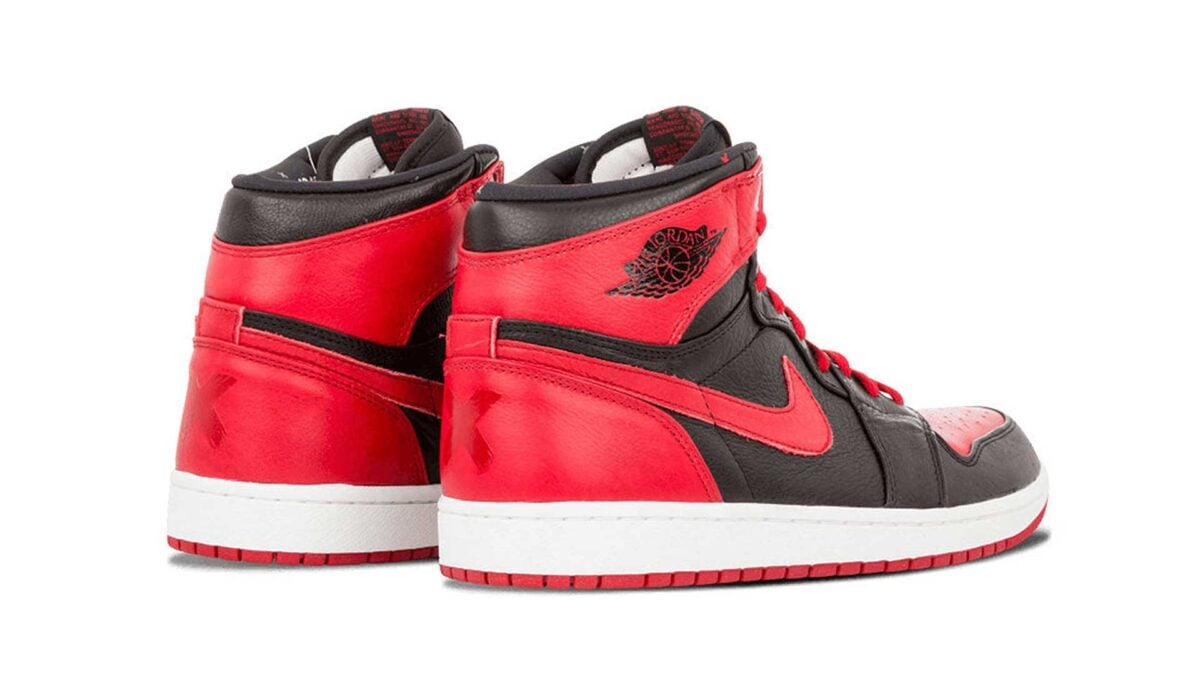
Nike has cemented itself as a leader in athletic apparel and footwear not just for its high-quality products, but for its brilliant marketing strategy. Over the years, Nike’s marketing campaigns have gone beyond being just mere ads, becoming cultural touchstones. They’ve expertly found a way to leverage the power of storytelling to connect with consumers on an emotional level, promoting Nike products not just as athletic gear, but as tools for empowerment and self-improvement for both athletes and consumers. This focus, alongside a strong emphasis on digital marketing and strategic partnerships with athletes and influencers, has ensured Nike’s brand visibility remains unmatched. The result? A legion of loyal fans who not only associate Nike with cutting-edge technology and performance, but also see it as a symbol of something bigger, fostering a strong brand identity that keeps them coming back for more. Still, not everyone approves of how they’ve gone about doing that, with some even questioning the ethics of Nike’s marketing strategy. In this article, we’re going to do a deep dive into this strategy and look at some of the positives and negatives of the company’s approach.
Nike’s Beginning
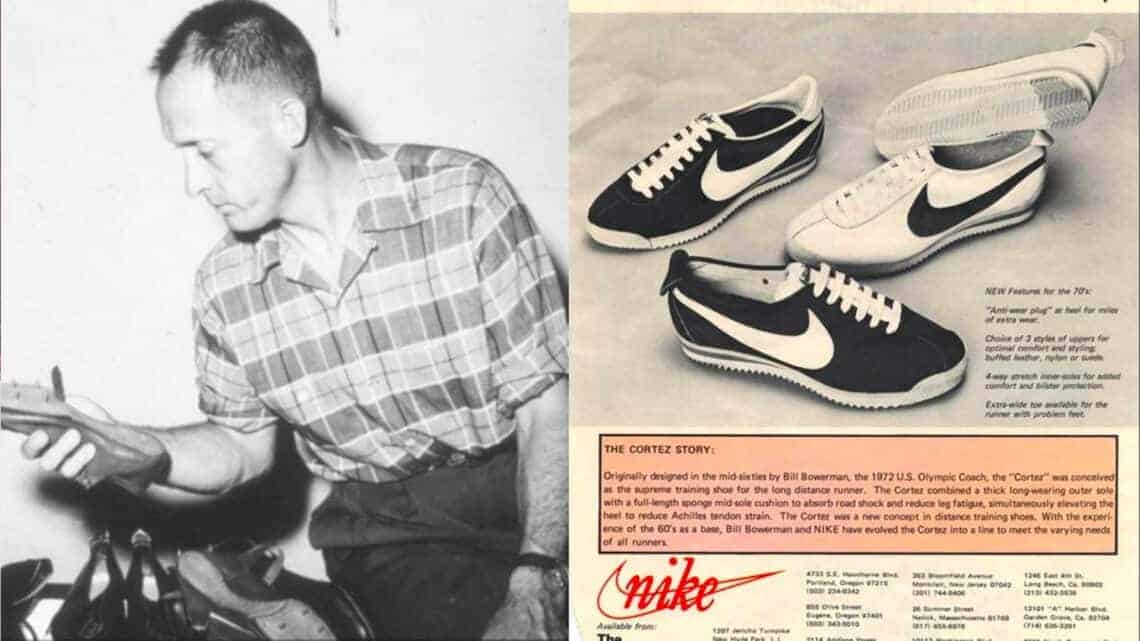
Nike is one of the world’s most recognised and influential brands, with a rich history that traces its origins to a small startup with a modest mission. Founded by track and field coach Bill Bowerman and his former athlete Phil Knight in January 1964 (long before the times companies could launch shiny advertising campaigns on their expertly curated social media platforms), Nike started as a sports apparel company focusing on athletic footwear. Known in its nascent years as Blue Ribbon Sports out of Beaverton, Oregon, Nike operated as a distributor for the Japanese sportswear company Onitsuka Tiger (now ASICS). Bowerman and Knight began by selling running shoes from the back of Knight’s car at track events. Still, regardless of whatever trials and challenges they came up against, they always retained sight of their vision: to create high-performance footwear that could help athletes and give them the inspiration they needed to reach their full potential.
Things pivoted when they decided it was time to design their shoes, and in 1971, they introduced the Nike brand name and Swoosh logo inspired by the Greek winged goddess of victory. This move began Nike’s evolution into an innovative sports apparel company. The story is the stuff of legend: Nike’s innovations in athletic footwear revolutionised the industry. The introduction of the Waffle Trainer with its unique tread pattern in 1974 demonstrated Nike’s commitment to creating industry-leading products. By the late ‘70s, Nike was making waves in the running world, and athletes started to realise the advantages of wearing Nike shoes, further solidifying its reputation.
Nike Sponsorships and Branding
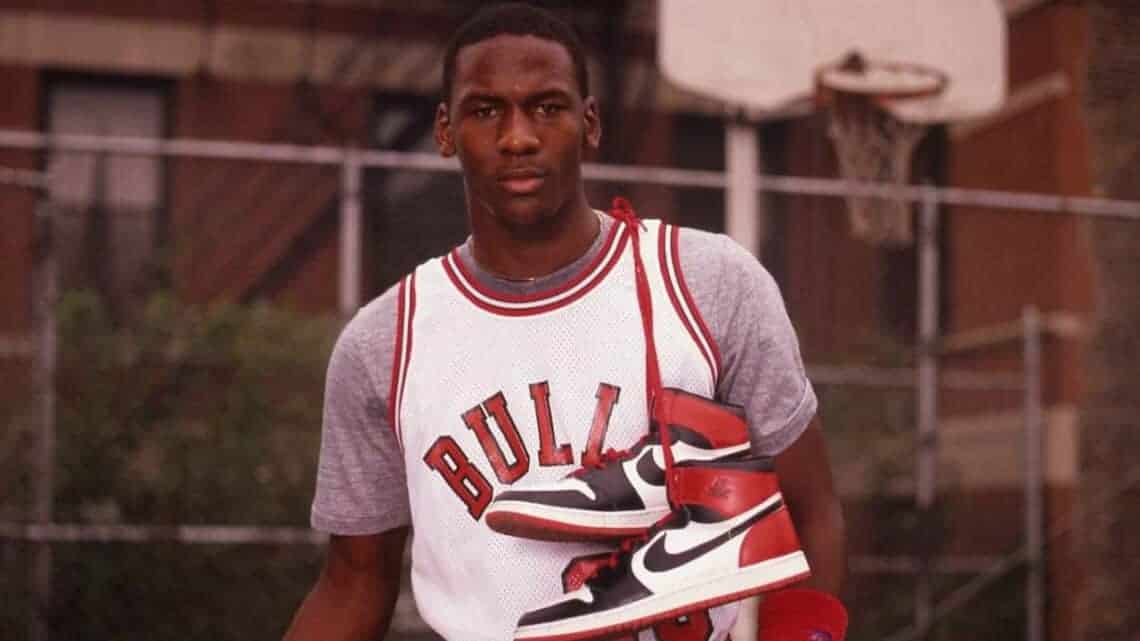
The 1980s saw Nike taking a giant leap forward by introducing an iconic slogan (Just Do It), and signing endorsement deals with high-profile athletes like Michael Jordan, launching the game-changing Air Jordan line. (Sidebar: you’ll be happy to know that we have a long-form article on our site where you can read a detailed account of the origins of Air Jordan and find out about every shoe that’s been released in that line till now.) These partnerships elevated Nike’s status as a sports apparel brand and sparked a sneaker culture that transcended the basketball court. The Air Jordan series became a cultural phenomenon, influencing sports, fashion, and lifestyle. Keep your eye on that word ‘culture’ because it will become a significant part of the case we’re making about how Nike’s evolution, as well as the decisions and strategies it later made and pursued, went beyond just becoming a part of the culture but also led it to shape culture, for better or worse.
RELATED: 10 Things The Air Movie Got Right and Wrong: A Fact-Check
Transitioning To Lifestyle Apparel

While Nike had a strong foothold in the sports market, the brand’s transition into lifestyle apparel was gradual and strategic. One of the critical factors was Nike’s ability to adapt to changing consumer tastes. It recognised that consumers, especially the younger generation, were increasingly valuing comfort, style, and versatility in their clothing. In response to these changes, Nike expanded its product lines to include streetwear and casual clothing. The introduction of iconic products like the Nike Air Max and the Nike Air Force 1 sneakers, initially designed for sports, found their way into everyday fashion. These shoes, known for their comfort and timeless design, became staples in urban wardrobes.
We should pause for a second and dig deeper here. Often, when narrating the story of a company’s growth, evolution, and meteoric rise to success, we tend to focus on the glamorous parts of the tale and ignore some of the challenges and arduous moments. While it may be true that Nike recognised what was happening with young consumers and their fashion choices, moving toward lifestyle apparel was challenging. There was a certain reluctance to commit to the lifestyle market fully. This hesitation stemmed from its deep-rooted athletic heritage and the challenges that came – and still come – with maintaining a delicate balance between sports and culture.
Nike’s DNA is, and has always been, undeniably athletic. Remember that the company initially focused on creating high-performance footwear for athletes. This dedication to sports excellence was a cornerstone of Nike’s early identity and success. Its groundbreaking innovations, athlete endorsements, and sports sponsorships were integral to its growth and brand recognition. Nike’s initial reluctance to completely pivot to a lifestyle-focused approach can be attributed to the fear of alienating its core customer base—the athletes. The brand invested heavily in sports, sponsoring elite athletes and teams, and remained committed to delivering top-tier athletic gear. For them, this commitment to sports wasn’t only about maintaining authenticity and keeping a competitive edge in a fiercely competitive industry.
These factors notwithstanding, Nike managed to leverage its growing credibility in the athletic space to create lifestyle products that appealed to a broader consumer base. Iconic silhouettes like the Air Force 1, Air Max, and Jordan 1 seamlessly transitioned from sports performance footwear to lifestyle staples. This dual approach enabled Nike to cater to a diverse audience while maintaining its authenticity in sports and lifestyle categories. The company, therefore, had to ensure that it constantly innovated and reinvented itself to stay relevant in the fast-paced world of fashion and streetwear. Here, we start to wade into the murky waters, where things get more interesting as we move on to the next chapter of the Nike story.
Air Jordan: Igniting Hype And Contention
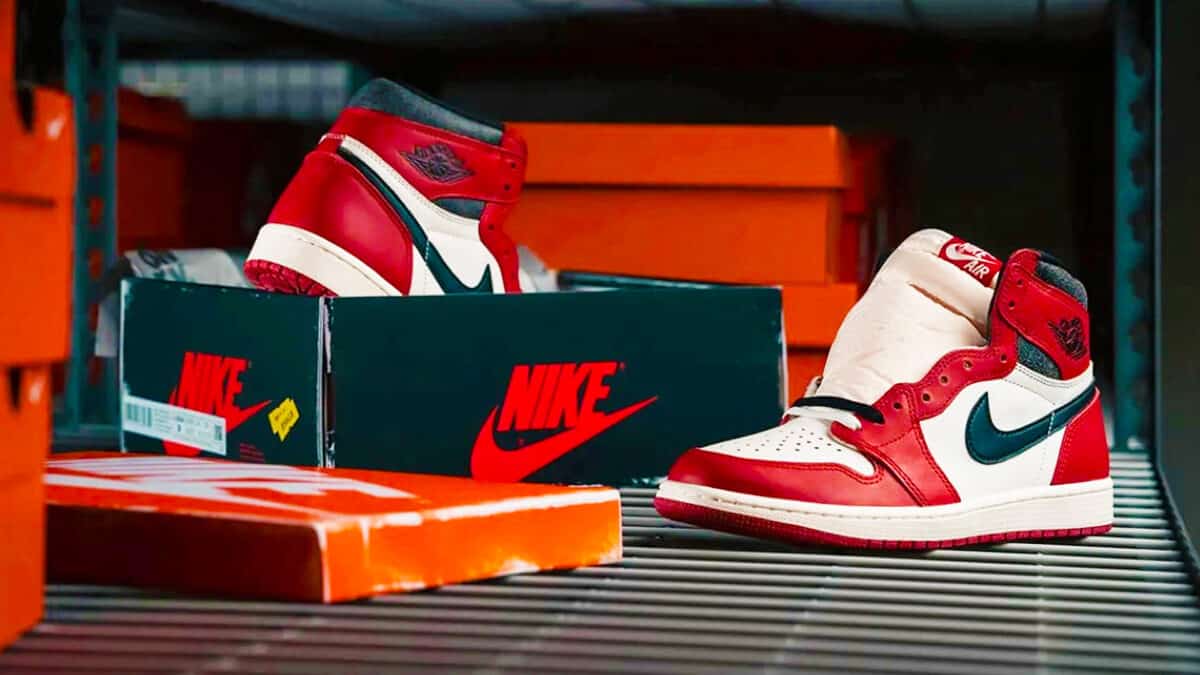
Few names evoke as much hype, passion, and contention in the world of sneakers as the Air Jordan line. Launched by Nike in 1985, the Air Jordan sneaker line, with basketball legend Michael Jordan as its face, revolutionised the sneaker industry and created a culture of unparalleled anticipation and enthusiasm. In this section of the article, we’ll talk specifically about how the Air Jordan sneaker line played a significant role in shaping the culture of hype and contention that we now see play out surrounding sneaker releases.
When Air Jordan was born out of a groundbreaking partnership between Nike and Michael Jordan, it was intended to be more than just a basketball shoe; it symbolised style, excellence, and athleticism. Michael Jordan’s exceptional talent on the court and the innovative design and technology of the Air Jordan sneakers made them an instant sensation. One of the ways in which Nike profited from this sensation, apart from the shoe sales themselves, which were quite significant, was to employ a strategy of limiting releases and creating scarcity. We all know how humans do when they get a whiff of the possibility that something they want or need may be in short supply. Does anyone remember the toilet paper shortages that occurred when COVID-19 came around? Well, a whole branch of economics and psychology deals with scarcity, and we will only go so deep into it here. Still, a helpful way to understand is to use this idea: “We perceive things as more desirable when there is a possibility we can’t acquire [them]”.
If we’re to geek out for a moment here, what we essentially saw with the Air Jordan line was Nike started to make use of the four types of scarcity that producers explore with their consumers:
- Exclusivity scarcity – the product itself isn’t exactly scarce, but acquiring it becomes more complicated with every price increase. This works well for people looking for status.
- Rarity scarcity – restricting the product supply from the start, making that edition extremely rare. Buying a rare product has similar effects on individuals as exclusive products. People purchase products to increase social status, reduce the feeling of powerlessness, and generate envy. It works well for people who want to feel unique.
- Urgency scarcity – a time restriction put on the consumer by the producer. Adding a deadline to a deal or the availability of a product or service increases urgency, making consumers feel they are somehow more intelligent than others.
- Excess demand scarcity – this form of scarcity that many of us will be familiar with instils fear in shoppers by telling them they may miss out on the hot item. Excess demand implies popularity and, at the same time, shows there isn’t much left of this popular item, so you better act.
To this day, Nike often releases new Air Jordan models in limited quantities, fueling that sense of urgency and exclusivity. Sneakerheads, collectors, and resellers alike scramble to get their hands on these limited-edition kicks, resulting in long lines, online raffles, and sometimes even chaos at release events. These limited releases often fetch astronomical resale prices, creating a lucrative secondary market.
Even back then, the resale market became a significant driver of contention within the Air Jordan culture. Sneaker resellers acquired coveted pairs and flipped them for substantial profits. While this practice gave entrepreneurs and collectors opportunities, it also sparked debates about ethics, fairness, and accessibility within the sneaker community. High demand and limited supply led to incidents of violence, sneaker-related crimes, and even tragic accidents at release events. Nike was criticised for seemingly encouraging this frenzy through its marketing strategies, which drew the ire of concerned parents, lawmakers, and community leaders, so the company had to address safety concerns and implement various approaches to minimise such incidents.
RELATED: 50 Popular Questions About The Nike Air Jordan 1s Answered
Recognising The Damage Of Brand Reputation
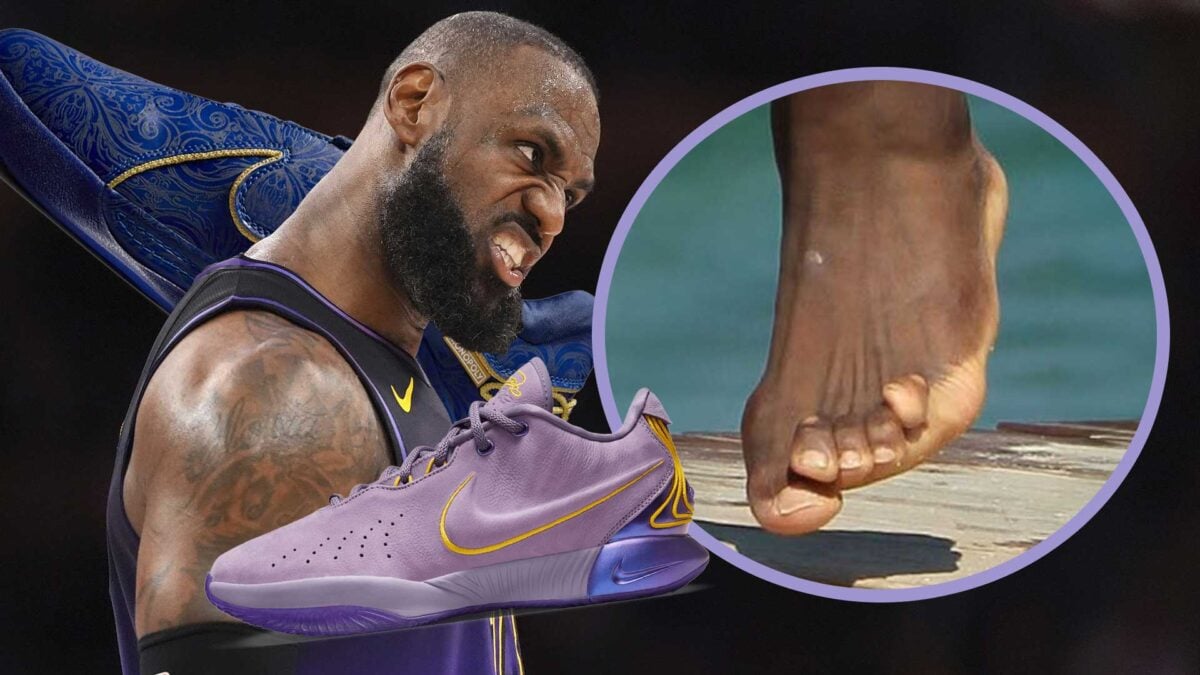
By the late 1990s and early 2000s, it was clear that Nike needed to address these issues to protect its brand reputation and regain the public’s trust. The negative press and controversy surrounding the Air Jordan line were beginning to overshadow the brand’s other accomplishments. Nike embarked on a strategic shift to change its image from a brand associated with controversy to a more wholesome and positive one. One of the key strategies employed was high-profile celebrity signings. Among them were:
- LeBron James. In 2003, Nike signed a rookie, LeBron James, to a $90 million endorsement deal, the most lucrative rookie contract in NBA history at the time. This move shifted the narrative towards a new era of basketball excellence, distancing Nike from past controversies.
- Kobe Bryant. Nike also secured an endorsement deal with Kobe Bryant, another rising star in the NBA. Bryant’s partnership with Nike added to the brand’s credibility and appeal.
- Serena Williams. Nike signed Serena for her winning record and marketability. She was a champion athlete (Grand Slam titles) who helped Nike expand into women’s sportswear and fit their image of empowerment as well as expanding Nike’s marketing mix. Their long-term partnership built brand loyalty among her fans.
- Cristiano Ronaldo. Few athletes are able to combine athletic performance, social media stardom (go check out how many followers he has across Instagram, Twitter/X and Facebook), and a marketable personality. Ronaldo fit Nike’s image of a global icon, boosted brand exposure with his massive following, and resonated with their marketing focus due to his outgoing nature.
- The Rebranding of Jordan Brand. Instead of focusing solely on the controversy surrounding Air Jordans, Nike rebranded the Jordan line. It was no longer just about sneakers; it became a lifestyle brand with a broader range of products, including clothing and accessories.
- Michael Jordan’s Image. Not everyone will know this, but Michael Jordan played a significant role in rehabilitating Nike’s image. He transitioned from an active NBA player to a retired legend who continued to represent the brand gracefully and professionally.
Nike’s strategic shift in the 2000s paid off in several ways. Firstly, it improved the reputation of the company. By distancing itself from past controversies and emphasising new stars like LeBron, Kobe Bryant, Serena and Ronaldo, Nike’s image improved significantly. Secondly, Nike maintained its dominance in the athletic footwear and apparel industry, solidifying its position as a global leader. Thirdly, the high-profile celebrity signings improved Nike’s brand image and had a profound cultural impact. The influence of athletes like LeBron James extended beyond sports into fashion and entertainment.
Nike Gets Deeper Into Fashion
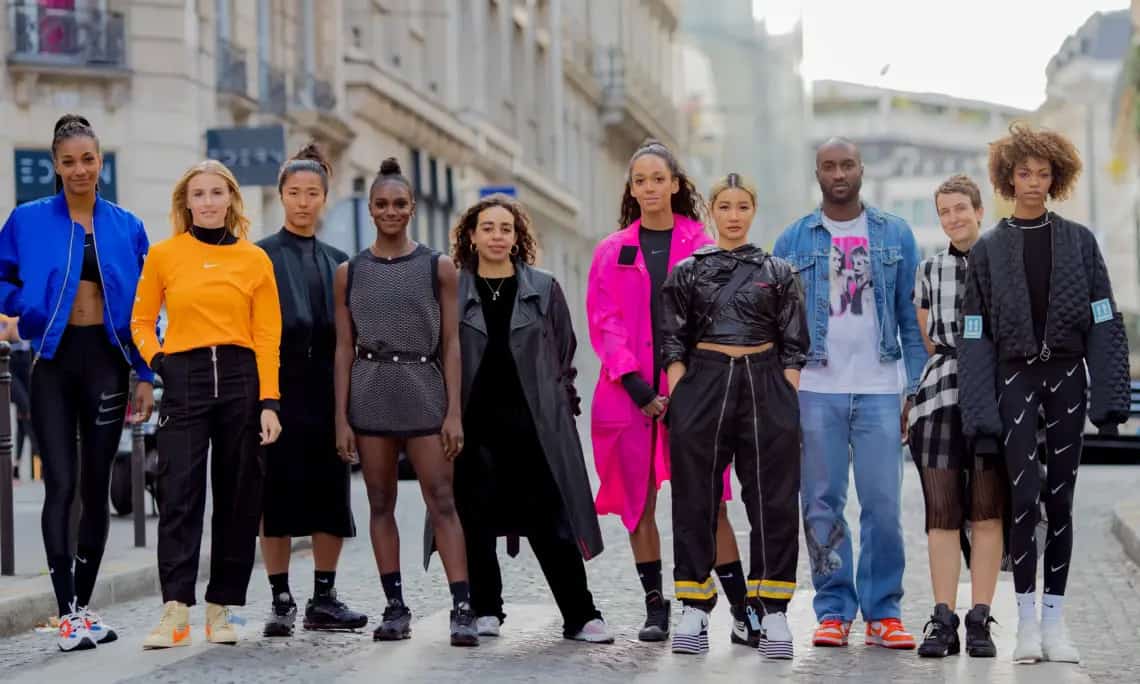
Now that the dust had settled, Nike moved on to the next phase of its growth strategy – it went deeper into the world of fashion. Earlier, we discussed how Nike’s core identity was deeply rooted in sports. In the early 2000s, however, Nike expanded its horizons by introducing the Nike Sportswear (NSW) line. This collection aimed to blend sport and fashion, offering streetwear-inspired designs that appealed to a broader audience beyond athletes, with the promotion of an active lifestyle for all. NSW became the catalyst for Nike’s transition into the fashion sphere. The company also recognised the potential of collaborations with renowned fashion designers.
Partnerships with industry leaders like Riccardo Tisci and Kim Jones resulted in limited-edition collections that combined high fashion aesthetics with Nike’s performance technology. Nike’s collaborations with celebrities were to become pivotal in its fashion transformation. The most notable partnership was with Kanye West. West’s collaboration with Nike was a game-changer. In 2009, Nike released the Air Yeezy, a sneaker designed in partnership with the rap superstar who himself had been eyeing domination of the fashion game for a long time. The Air Yeezy was an instant hit, selling out within minutes and gaining immense popularity in sneaker and fashion circles. The shoe’s groundbreaking design features unique materials and an edgy, fashion-forward aesthetic.
The Air Yeezy 2, released in 2012, continued the partnership’s success. This sneaker incorporated reptile-inspired textures and an instantly recognisable “Yeezy” logo, setting a new standard for sneaker collaborations. However, despite the success, Kanye West eventually parted ways with Nike, signing with Adidas to launch his Yeezy brand. While initially a blow to Nike, this transition further fueled the brand’s fashion evolution. In addition to Kanye West, Nike collaborated with various celebrities, including Travis Scott, Off-White founder Virgil Abloh (he’ll come up again later), and Drake. These partnerships resulted in highly sought-after releases, solidifying Nike’s status as a fashion powerhouse. Furthermore, Nike’s involvement in streetwear culture and its collaborations with brands like Supreme and Comme des Garçons – we’ll mention them a little bit more later – demonstrated its commitment to staying on the cutting edge of fashion.
Nike’s Lessons from Ye – More Hype
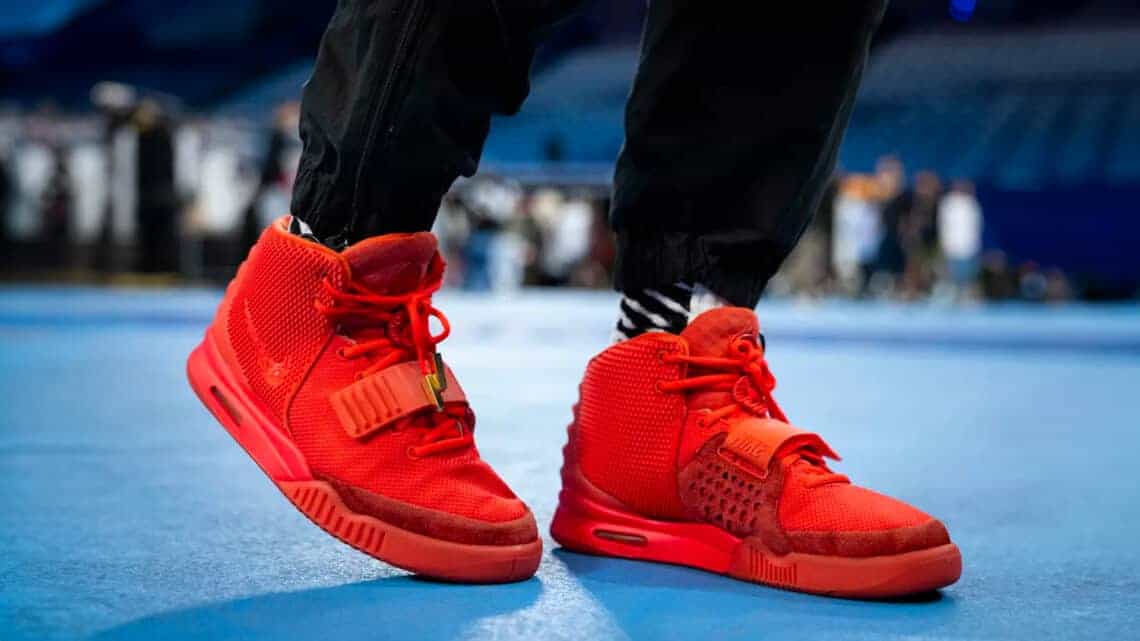
Let’s stay with the Kanye West period of Nike’s story. Earlier, we talked about how the Air Jordans introduced the idea of using hype to create noise – and therefore guaranteeing sales – into the mix. If the Air Jordans were the beginnings of that approach, the Air Yeezy era was where Nike mastered the art. Nike’s experience with Kanye West was a critical turning point in the brand’s evolution regarding harnessing the power of hype to sell its products without risking too much or overextending resources.
Though the Kanye West collaboration birthed terrific products, it was also a mixed bag. Ye, known for his outspoken nature, expressed frustration with Nike’s unwillingness to grant him creative freedom and the profits he believed he deserved. This discord culminated in Kanye West parting ways with Nike in 2013 and signing with Adidas, as mentioned before. Still, despite everything that didn’t work out in the relationship, it was a valuable learning opportunity for Nike. It highlighted the importance of collaboration dynamics, creative control, and the potential risks of associating too closely with a single individual or brand. From this experience, Nike gleaned several essential lessons and perfected what it had learned from the Air Jordan releases:
- The Value of Collaborative Flexibility: Nike recognised that granting creative freedom to collaborators was essential. Collaborators like Kanye West brought unique design perspectives and cultural influence, which was a potent formula for creating hype. Nike shifted its approach, becoming more open to allowing designers and influencers more creative control in subsequent partnerships.
- Diversification: The Kanye West collaboration taught Nike the importance of diversifying its collaborative efforts. Instead of relying on a single celebrity or designer to drive sales and generate buzz, Nike began working with a broader range of collaborators across different genres. This approach helped reduce the brand’s vulnerability to potential fallout from a single partnership.
- Scarcity and Limited Releases: The limited release strategy employed for the Air Yeezys was a significant success factor. They’d already applied this to a great degree with the Air Jordans in previous years, but they took it to a new level with the Yeezys. Nike demonstrated again that scarcity drives demand and fuels hype. Subsequently, Nike began releasing limited-edition sneakers and apparel, creating a sense of urgency and exclusivity among consumers.
- Strategic Timing: Nike further mastered the art of timing its releases to coincide with significant cultural moments or events. Nike could generate organic buzz and anticipation among consumers by aligning product drops with pop culture milestones.
- Next Level Marketing and Storytelling: The Kanye West collaboration demonstrated the power of storytelling and marketing in building hype. Nike started to invest more in creating compelling narratives around its products, leveraging its collaborators’ cultural and personal stories.
In the years following the Kanye West collaboration, Nike continued to evolve its approach to generating hype while mitigating risks. The brand’s “less is more” strategy, focusing on quality over quantity, became a hallmark of its success. Some critical elements of this evolved approach included:
- Establishing a diverse ecosystem of collaborators, including athletes, musicians, fashion designers, and artists. This helped broaden the brand’s appeal and reach various demographics.
- Investing heavily in innovative technologies and materials, ensuring that its products looked stylish and performed exceptionally well. This focus on performance appealed to athletes and enthusiasts alike.
- Engaging with its audience through social media, apps, and events, creating an inclusive community of fans and collectors. This community engagement played a crucial role in sustaining and amplifying hype. The negative side of this was the contention that would often be created, pitting people in the Nike community against one another.
- Embracing sustainability initiatives as environmental concerns grew around the world. This commitment resonated with a new generation of conscious consumers.
- Maintaining a consistent and steady stream of collaborations, ensuring that hype remained a constant part of its brand identity.
More Collabs, More Angst
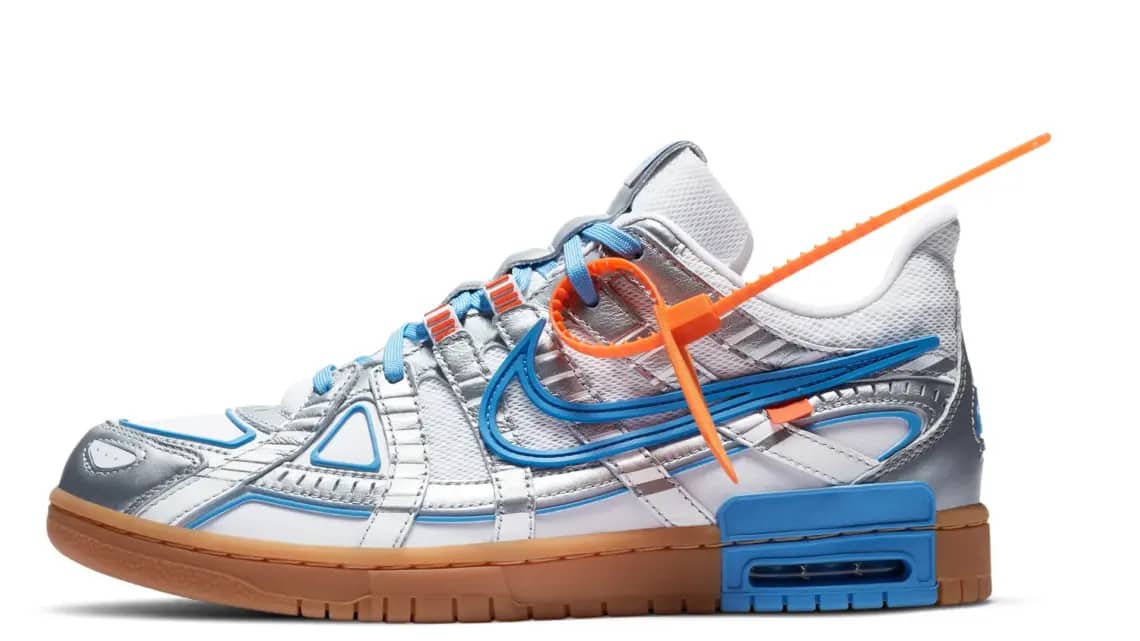
In the sneaker culture world, nothing captures enthusiasts’ hearts more than limited edition releases. Sneakerheads, collectors, and fashion enthusiasts eagerly anticipate the thrill of acquiring these rare gems. Seeing this, Nike recognised the immense potential of re-releasing limited-edition sneakers as part of their strategic playbook. This move not only appeased fans but also stirred up controversy within the Nike community, especially with resellers now seeing their potential for profit shrink. By now, it should be abundantly clear how Nike was playing a shifty but highly profitable game using its community. Yet, simultaneously, they were giving the people what they wanted.
For the longest time, enthusiasts had clamoured for the chance to purchase classic, iconic models that had become increasingly rare and expensive on the resale market. Nike heeded their call and began systematically re-releasing highly coveted models, sparking excitement and angst. Many passionate sneakerheads and collectors initially felt that re-releasing limited-edition sneakers devalued their prized possessions. Some argued that the rarity and exclusivity of these shoes were what made them special. Re-releases, they contended, diluted that uniqueness. Nike took this controversial stance in stride, understanding that the prospect of re-releases could fuel anticipation and heighten demand. They also appreciated the need to balance catering to collectors and ensuring more comprehensive access to their products.
Nike’s strategy of re-releasing limited-edition sneakers paid off spectacularly in terms of profits and strengthening their partnerships with influential designers and brands. Here are some of the collabs that scored big for Nike:
- Jun Takahashi and Undercover: Nike’s longtime collaboration with Japanese designer Jun Takahashi and his brand Undercover showcased re-releases’ power. This partnership, which began with the Nike GYAKUSOU running collection, evolved to include classic sneaker models with Takahashi’s unique design sensibilities. Re-releasing these sneakers allowed a broader audience to appreciate his creative vision while collectors could still obtain exclusive iterations.
- Hiroshi Fujiwara: Hiroshi Fujiwara, a Japanese streetwear legend, enjoyed a long-lasting partnership with Nike. Re-releasing iconic Fragment Design collaborations, such as the Fragment Design x Air Jordan 1, allowed a new generation to experience the magic of Fujiwara’s designs, generating immense buzz and demand.
- Virgil Abloh: Designer Virgil Abloh’s collaboration with Nike resulted in “The Ten,” a groundbreaking collection that deconstructed and reimagined iconic Nike sneakers. Re-releasing these sought-after designs added an element of accessibility to the partnership, making Abloh’s work even more influential and profitable.
- Comme des Garçons: Japanese brand Comme des Garçons’ collaborations with Nike Lab demonstrated that re-releases can also be a platform for experimentation. Through these partnerships, Comme des Garçons explored unique materials and avant-garde design, captivating a diverse audience and solidifying their status as innovators in the fashion world.
Though the re-release of limited-edition sneakers was initially met with resistance from collectors, it paid off handsomely for Nike. Exploring this path allowed the company to democratise access to coveted designs, fuel demand, and nurture lasting collaborations with visionary designers. The controversies surrounding these re-releases demonstrated that a touch of contention can be a powerful catalyst for innovation, profitability, and creative partnerships in sneakers and fashion.
The Ordinary Guy
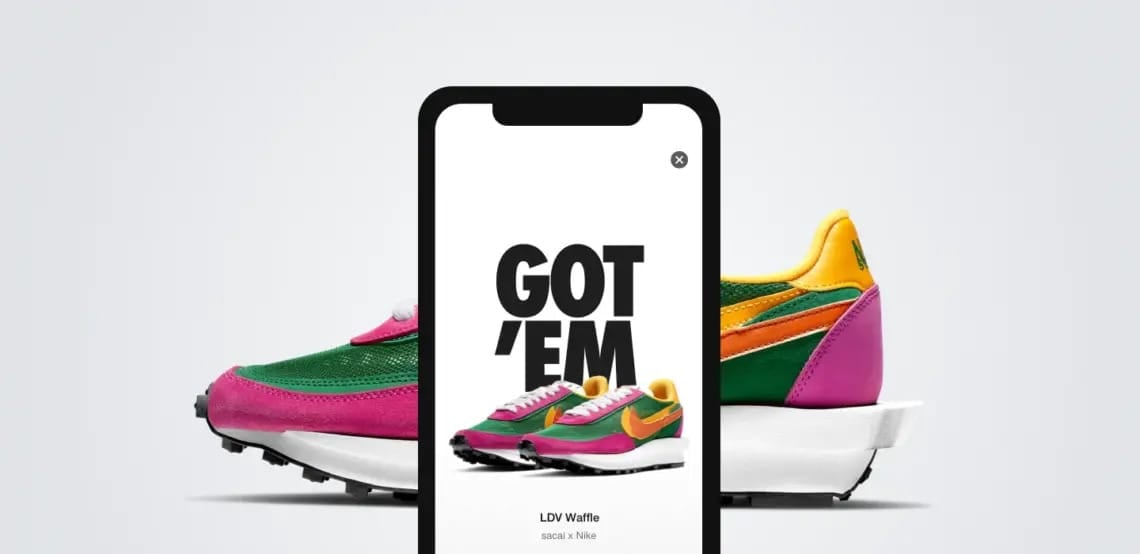
So far, we’ve taken a bird’s eye view of Nike’s journey, mentioning some high-level collaborations and looking deeper into strategy. We’ve also discussed hype, contention, and angst several times, specifically regarding the community. It’s worth mentioning the issues that ordinary Nike fans and customers have had to deal with or endure in contending with the company’s somewhat controversial marketing strategy and approach.
In the digital age, Nike turned to mobile apps to manage the release of their highly sought-after sneakers. These apps were intended to make the buying process fairer and more accessible. However, many customers found themselves experiencing immense frustration with the term “L-taking” entering the sneakerhead lexicon. The process typically involved customers repeatedly refreshing their apps, only to discover that their desired sneakers had sold out within seconds of release. This frustration gave rise to a cottage industry of resellers who used bots to secure multiple pairs, leaving genuine enthusiasts empty-handed and disheartened.
The second issue concerns backdoor business and sneaker stores undermining fairness. Sneaker stores, both large chains and local boutiques, often play a central role in sneaker releases. However, customers have been disheartened to discover that some stores engage in backdoor business, selling exclusive sneakers to friends or resellers before the official release. This practice not only undermines the fairness of the sneaker game but also erodes trust between customers and retailers. When a sneakerhead arrives at a store for a release only to find that all the stock has mysteriously vanished before the doors even open, frustration and disappointment inevitably follow.
Lastly, there’s the issue of proxy shoppers – yes, that’s real. To cope with the challenges of acquiring limited edition Nike sneakers, some enthusiasts have resorted to hiring proxy shoppers or “campers” to stand in line for them. While this tactic can be effective, it also comes with its frustrations. Proxy shoppers often charge hefty fees for their services, sometimes adding significant costs to the already expensive retail price of exclusive sneakers. This added financial burden can frustrate customers looking to secure a pair to add to their collection.
We’ve All Been Fooled By The Nike Marketing Strategy
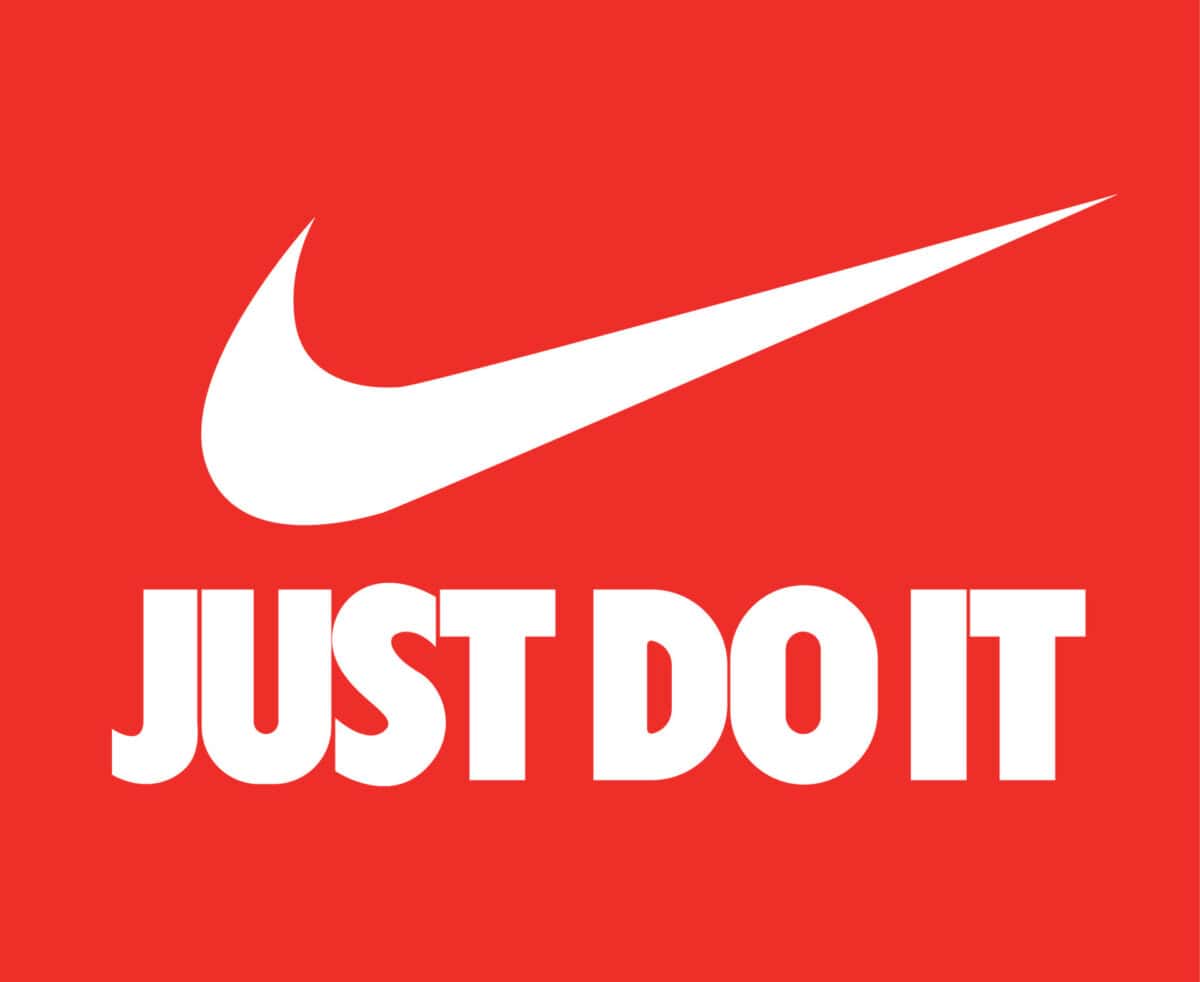
So, here’s the real question – has this chaos been part of Nike’s master plan all along? Have you been duped by a company that would have you believe you’re part of an extraordinary global community, yet it planned to do whatever it can to squeeze the dollars out of you? Have the things we’ve seen from Nike’s controversial marketing strategy been about orchestrated chaos, or was it all just unintended fallout?
Nike may have been orchestrating the chaos surrounding sneaker drops all along, steering the ship while sneakerheads navigate the turbulent seas of limited releases. We put it to you that the frustrations around sneaker releases weren’t just an unintended consequence of high demand and limited supply. Still, Nike subtly encouraged it to stoke the fire of desire. The prevalence of sneaker resellers who use automated bots to secure multiple pairs, subsequently flipping them for a profit, suggests sophistication beyond mere coincidence. Could Nike have been aware of this reselling market and the frustration it generates among genuine sneakerheads, ultimately adding to the hype surrounding their releases?
Nike’s penchant for releasing sneakers in minimal quantities has raised eyebrows. Sneakerheads have long questioned whether these scarcity tactics are a deliberate strategy by the brand to create a sense of urgency and desirability. Using raffles, draws, and mobile apps to distribute limited stock has become common practice, but is it about ensuring fairness and accessibility, or is there a calculated intent to keep the demand far exceeding the supply? This calculated scarcity has undoubtedly added to the mystique of Nike releases.
Could the occasional exposure of backdoor sales serve as a smoke screen, allowing Nike to maintain plausible deniability while benefiting from the buzz and intrigue generated by these controversies? Some argue that such controversies only bolster the brand’s visibility and desirability. Is it possible that Nike is aware of the proxy shoppers trend and indirectly benefits from it? Nike may enjoy the financial windfall without overtly participating in these practices by inflating the secondary market prices through proxy shoppers and resellers.
While it remains speculative whether Nike has been orchestrating the chaos surrounding sneaker releases all along, one thing is clear: the brand has mastered the art of generating hype and contention to drive sales and maintain its position at the forefront of sneaker culture. Whether these controversies are part of a grand marketing strategy or unintended consequences of high demand, they undeniably keep enthusiasts engaged and the brand in the spotlight.
And staying in the spotlight, it has… brilliantly so. Nike has managed to remain in the spotlight and become a cultural icon by expanding its influence beyond sports and fashion, the intersection of which we talked about at length throughout this piece. The company has entwined itself with modern life, including social, political, and technical spheres.
A prime example of this is Nike’s Colin Kaepernick saga. Nike’s partnership with Colin Kaepernick was a defining moment in the brand’s transformation into a socially conscious entity. Kaepernick, a former NFL quarterback, became a symbol of peaceful protest against racial injustice by taking a knee during the national anthem before a big game. Nike’s decision to make him the face of its “Just Do It” campaign in 2018 was a bold move that sparked intense debates. The move was polarising, drawing both support and backlash. However, it firmly positioned Nike as a brand that stands with those advocating for social change. It resonated with a new generation of consumers who value brands that take a stand on important issues. Nike’s engagement in social activism was a pivot away from mere fashion and sports and toward becoming a voice for change.
Beyond social issues, Nike has made waves in the political arena. The Kaepernick campaign had broader implications, putting Nike at the intersection of politics and culture. The brand was unafraid to wade into the turbulent waters of political discourse, reinforcing its presence in the modern sociopolitical landscape. While this decision invited controversy and calls for boycotts, with some even publicly burning their Nike sneakers and other apparel, it also garnered immense support from those who admired Nike’s courage to engage in meaningful dialogues and challenge the status quo.
Nike has also expanded into the technical aspects of modern life. The brand’s focus on innovation has led to the development of cutting-edge athletic technologies, such as the Nike Adapt self-lacing shoes and the Nike Run Club app. By embracing technology and staying at the forefront of advancements, Nike remains relevant to tech-savvy consumers.
Nike’s ability to evolve and entrench itself in all aspects of modern life, from addressing social issues to embracing technological innovations, has been instrumental in maintaining its relevance. The Colin Kaepernick saga served as a significant turning point, demonstrating that Nike was willing to take risks and actively engage with the evolving values of contemporary society.
Regardless of how you feel about Nike as a brand or even whether you agree or disagree that their tactics have, at times, made fools of us all, everything in the last few paragraphs points to the simple fact that companies, at their core, are about profits. Everything else they do – the programs, the movements, the anthems – comes second. Nike hasn’t done anything that every other major corporation isn’t working on doing, which is to please its shareholders through premium pricing, and make as much money as possible. So, when we look at what the company has done over the many years of its existence, we may feel like casting stones at them and accusing them of being shameless, calculating, and ruthless – mind you, we didn’t even touch on the sweatshop allegations here – but the cold, hard truth is that profit is the name of the game.
RELATED: Nike Marketing Strategy 2024 – 7 Effective Findings from Case Studies
A Marketing Saturated World
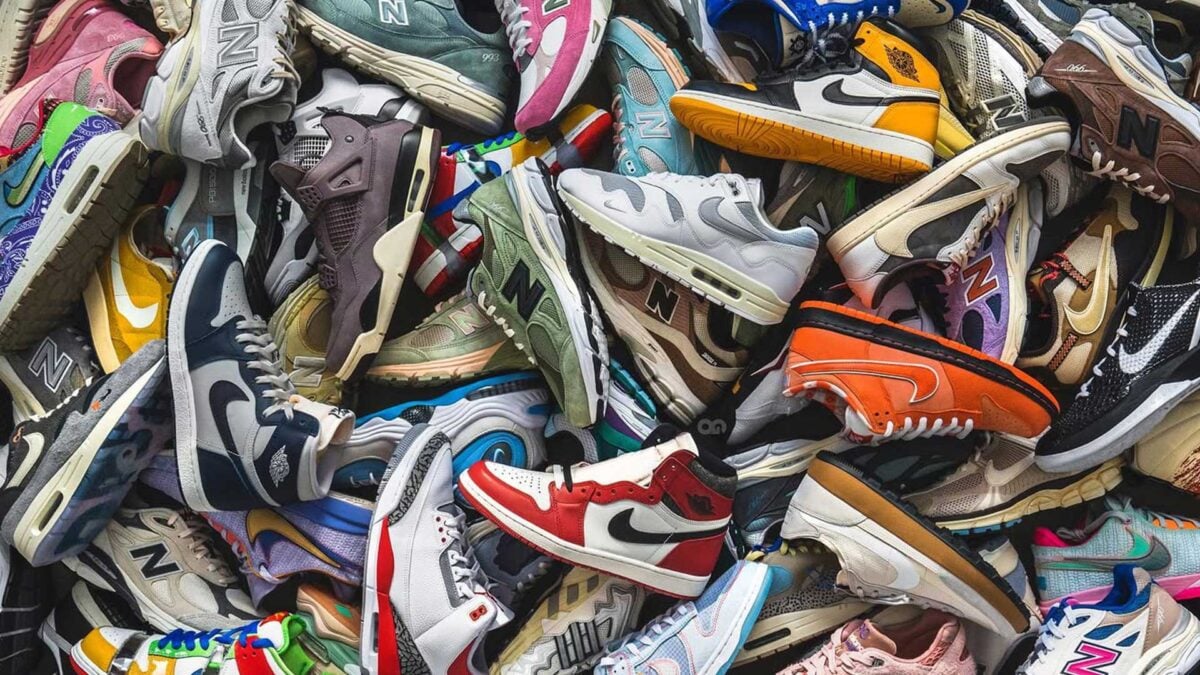
In today’s marketing-saturated world, it’s up to all of us as consumers to exercise critical thinking when evaluating the messages we receive from companies, whether directly through advertisements or indirectly through influencers and social media. Without sounding too much like a consumer advocacy piece here, we need to recognise that our purchasing power is a valuable resource, so we prioritise making informed and considered decisions before unquestioningly believing in the promises and claims made by companies. By scrutinising marketing tactics (including Nike’s marketing strategy) and getting acquainted even a little bit with the psychology behind the messaging, we can ensure that our hard-earned money is spent wisely, supporting businesses that align with our values and genuinely deliver on their promises.
So, do you believe that Nike has been playing a dirty game and has fooled the whole world into thinking it is a different type of company? Have you fallen for Nike’s clever marketing strategy? Let us know.


